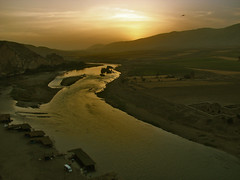From Hunting and Gathering to Civilizations, 2.5 million-1000 B.C.E.: Origins
Original from MrsBHatchTEACHER
| 14848491127 | hunting and gathering | Means of obtaining subsistence by humans before the mastery of sedentary agriculture; normally typical of tribal social organization |  | 0 |
| 14848491128 | civilization | Societies with reliance on sedentary agriculture, ability to produce food surpluses, and existence of nonfarming elites, along with merchant and manufacturing groups | 1 | |
| 14848491129 | neolithic | The New Stone Age between 8000 and 5000 B.C.E.; period in which adaptation of sedentary agriculture occurred; domestication of plants and animals accomplished |  | 2 |
| 14848491130 | nomadic societies | livestock hearding societies that do not have a permanent settlement. normally found on the fringes of civilized (urban) societies; commonly referred to as "barbarian" by civilized societies |  | 3 |
| 14848491131 | culture | Combination of ideas, objects, and patterns of behavior that result from human social interaction |  | 4 |
| 14848491132 | agrarian revolution | Occurred between 8000 and 5000 B.C.E.; transition from hunting and gathering to sedentary agriculture |  | 5 |
| 14848491133 | pastoralism | A nomadic agricultural lifestyle based on herding domesticated animals; tended to produce independent people capable of challenging sedentary agricultural societies |  | 6 |
| 14848491140 | city-state | A form of political organization typical of Mesopotamian civilization; consisted of agricultural hinterlands ruled by an urban-based king |  | 7 |
| 14848491142 | Babylonian Empire | Unified all of Mesopotamia circa 1800 B.C.E.; collapsed due to foreign invasion circa 1600 B.C.E. |  | 8 |
| 14848491143 | Hammurabi | The most important Babylonian ruler; responsible for codification of the law |  | 9 |
| 14848491144 | Pharaoh | The term used to denote the kings of ancient Egypt; the term, "great house" refers to the palace of the pharaohs |  | 10 |
| 14848491145 | pyramids | Monumental architecture typical of Old Kingdom Egypt; used as burial sites for pharaohs |  | 11 |
| 14848491146 | hieroglyphs | Form of writing developed in ancient Egypt; more pictorial than Mesopotamian cuneiform |  | 12 |
| 14848491148 | monotheism | The exclusive worship of one god; introduced by Jews into Middle Eastern civilization |  | 13 |
| 14848491149 | Phoenicians | Seafaring civilization located on the shores of the eastern Mediterranean; established colonies throughout the Mediterranean |  | 14 |
| 14848491153 | Shang | 1st Chinese dynasty (after the legendary Xia) |  | 15 |
| 14848491154 | Oracles | Shamans or priests in Chinese society who foretold the future through interpreting animal bones cracked by heat; inscriptions on bones led to Chinese writing |  | 16 |
| 14848491155 | ideographic writing | Pictograph characters grouped together to create new concepts; typical of Chinese writing | 17 | |
| 14848491157 | Paleolithic | The period that ended about 3,000 years after the end of the last Ice Age, it lasted until about 10,000 years ago. (Old Stone Age) The period of the Stone Age associated with the evolution of humans. It predates the Neolithic period. |  | 18 |
| 14848491158 | Human migration during Paleolithic era | movement of humans from Africa to Eurasia, Australia, and the Americas | 19 | |
| 14848491159 | eglitarian | equality among people (no social levels) | 20 | |
| 14848491160 | tools | Humans developed a wider range of ____ specially adapted to different environments from tropics to tundra | 21 | |
| 14848491161 | Neolithic Revolution | period of change from hunter-gatherer lifesyle to agricultural lifestyles associated with domestication, farming, and settlement |  | 22 |
| 14848491162 | patriarchy | father based/male dominated society |  | 23 |
| 14848491163 | climatic change | Permanent agricultural villages emerged first in the lands of the eastern Mediterranean, possibly as a response to what? | 24 | |
| 14848491164 | weapons | Pastoralists were often the developers and disseminators of of ____ and forms of transportation that transformed warfare in agrarian civilizations | 25 | |
| 14848491193 | Nile River | This river flooded regularly. |  | 26 |
| 14848491194 | Tigris River | This river's floods were unpredictable. |  | 27 |
| 14848491195 | Mesopotamian | Unpredictable weather patterns affected the development of the _____ civilization. | 28 | |
| 14848491196 | Egyptian | _______art demonstrated little change for nearly 1000 years. | 29 | |
| 14848491197 | Nubia and Kush | Kingdoms upriver from Egypt. | 30 | |
| 14848491198 | Jericho | One of the earliest cities: located in modern Israel. |  | 31 |
| 14848491200 | Filial Piety | In Confucian thought, one of the virtues to be cultivated, a love and respect for one's parents and ancestors. | 32 | |
| 14848537625 | Daoism | egalitarianism, balance is equal but men are still in charge , "does anything matter" founder is Laozi | 33 | |
| 14848555909 | confucianism | society is broken and needs to return to the golden age of the early zhou, emphazised family obligations, 5 basic relations, devotion to ruler, compassion founder s kongzi | 34 | |
| 14848570253 | legalism | law and order, strengthen state no matter the cost, strict laws, worked in agriculture and military, rejected confucianism founder is shi huangi | 35 | |
| 14848589341 | buddhism | rejects caste system, women can be nuns, middle path, 4 noble truths and 8 fold path, similar to christianity, appeals to lower classes founder is siddhartha gautama | 36 | |
| 14848617650 | hinduism | pro caste system, "you are where you deserve to be" founder is arians | 37 | |
| 14848629608 | Shinto | A Japanese religion whose followers believe that all things in the natural world are filled with divine spirits | 38 |

